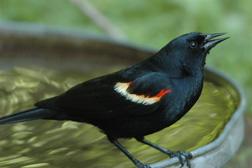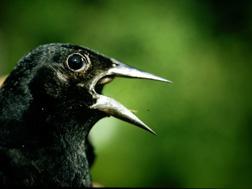Red-winged Blackbird
- Share
- Tweet
- Pin
- Share

Male Redwing uses a birdbath. Photo by Roy Lukes.
The return of nesting birds usually signals the start of the spring season to us, and that magical moment has occurred a few times here in past years with a foot or more of snow still covering the ground. It was on March 19, 1972 that a friend was snowshoeing with me along the shore of Toft Point that I suddenly heard “o-ka-LEEE-o-ka-LEEE” over and over. The first Red-winged Blackbirds had returned for the nesting season.
Nothing, no, nothing comes even close to making the delightful musical call of this dapper creature of the wetlands and fields. How strongly and beautifully it carries. “O-ka-LEEE, ong-ka-LEEE, conk-kar-EEEE.” These are a few of the phonetic analyses people like to associate with the male Redwing’s song.
As more and more Redwings are joined by Song Sparrows and other equally good singers, the beauty of the Red-wings’ songs tends to wear off. It’s that very first one that thrills me right down to my toes. Perhaps it is the reassurance of spring’s arrival that is really most welcome of all, for Redwings don’t make seasonal mistakes.
Few people realize the importance of the songs of birds, but fewer know that Red-winged Blackbirds combine their songs with marvelous displays of their colors. Call it a song-spread display. Observe a male Redwing sing, and you will note that his head is thrust forward, tail and wings are lowered, and his red shoulder patches, his epaulets of authority, tend to enlarge and puff up. When the bird produces the drawn out “LEE” portion at the end of his song his posture has reached its extreme, nearly that of a contortionist. Now he means business. Every ounce of his body seems to be thrown into this shrill colorful challenge to all other male Redwings within sight or hearing distance.

Male Redwing in flight over marsh. Photo by Roy Lukes.
The crux of the matter is that for him to get a wife means that he must have a good territory, and territories don’t just happen or develop without a fight. In order to announce his presence to the world the male Redwing will perch on the highest stalk or branch in his territory and pour forth with his musical challenge. His final territory may include as little as 1,000 square feet or as much as 10,000 square feet.
Get close to this creature’s territory, or especially to one of his mate’s nests, and you are in for a rude awakening. Sweet songs will not greet you but rather a sharp, scolding, persistent “chuck-chuck-chuck.” And don’t be surprised if this black keeper of the cat-tails acts as though he will land on your head any second! We have often observed the highly territorial and feisty males drive other birds, including Crows, Ravens and hawks, away from the Redwings’ nesting territories. In a few instances the Redwings actually briefly landed on the backs of the Crows.
An ornithologist, in order to learn more about the song-spread display of the male Redwings, captured a number of them and dyed their bright crimson epaulets black. Black! Poor things! To some of the males this perhaps meant losing their territories, now that they had been stripped of their colors. To others it made no difference whatsoever. Matter of fact some males, minus their bright epaulets, lured as many as six female Redwings into their territories. Yes, Redwings are polygamous! The conclusion of this human’s study was that females will choose a male on the basis of the quality of his territory, not on how flashy, big and red his epaulets are nor how beautifully he sings.
Male Redwings take on their glossy black plumage and red shoulder epaulets after their second year. Before their molt to black plumage they had only a hint of red on their shoulders and their body feathers were similar to the females’, brown above, heavily streaked below, and with a light streak above the eye.

A female Redwing grasps marsh reeds. Photo by Roy Lukes.
Redwings often will travel in enormous flocks with Brown-headed Cowbirds and Common Grackles. Huge roosts of thousands have been recorded. One winter roost in Dismal Swamp, VA held an estimated 15 million, primarily Redwings. It’s easy to imagine the extensive damage flocks of this size are capable of inflicting on grain and rice fields ready to be harvested. Ordinarily Redwings feed mostly in open fields on weed seeds and waste grain resulting from mechanical harvesting. Roughly three-quarters of their food is vegetable matter while one-quarter is animal, including flies, moths, beetles and caterpillars.
We learned a number of things by experience during the past few summers from three unmated male Redwings that came regularly to eat the cracked corn scattered on the ground and sunflower seeds on our platform feeders. Those bossy blackbirds warned us non-stop with their shrill, ear-piercing alarm whistles that we should “get lost” whenever we got too close to their feeding activities. Soon I will stop putting out cracked corn for the birds and other wild creatures, until the arrival of the fall season. Fortunately Redwings winter primarily in the Southeast, well away from here!
Occasionally a bird sheds new light on how many years one can live. I was banding birds at the Ridges Sanctuary a number of years ago with a class of fifth graders and one of the birds we captured was a male Red-winged Blackbird. While I was handling it I pointed out the extremely pointed and sharply-angled rear claw of Redwings that enables them to cling firmly to vertical reeds in their environment. I also learned to handle these birds cautiously because of their unusually strong feet. Much to my pleasure he was already banded. I recognized the first three digits (622) on his aluminum leg band as possibly being my band series from a previous year.

Head of male showing sharp pointed beak. Photo by Roy Lukes.
As soon as I recorded the band number and released the bird I went into the house to check my records. You can imagine my surprise when I learned that I had banded that bird, when it already was an adult, 10 years earlier. In other words that Redwing could have been two or more years older than 10 years. Other banding records reveal that they can live to between 14 – 15 years. What tough resourceful birds they are.
To this day the singing star of our spring stage continues to be the male Red-winged Blackbird. Polygamous, aggressive, boisterous, unknowingly destructive at times to farmers’ crops – none of these traits will prevent this flashy and bossy master of the marshes from being our earliest champion songster of spring. Mr. Redwing, we’ll welcome you back as we have for many years!

